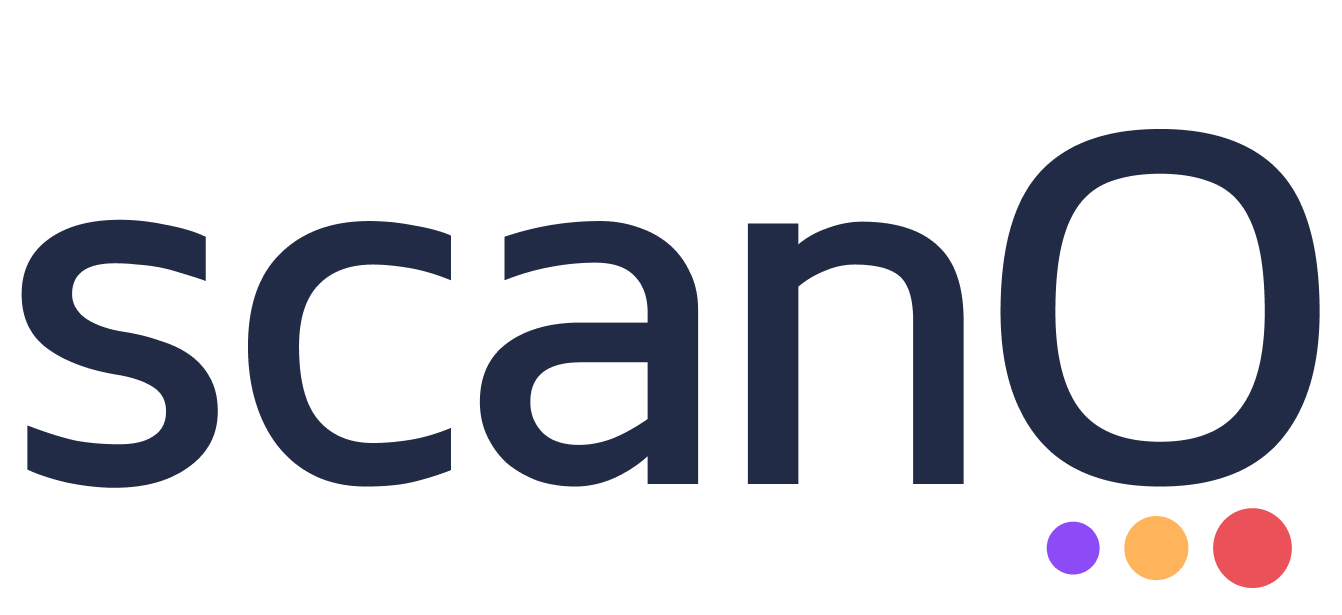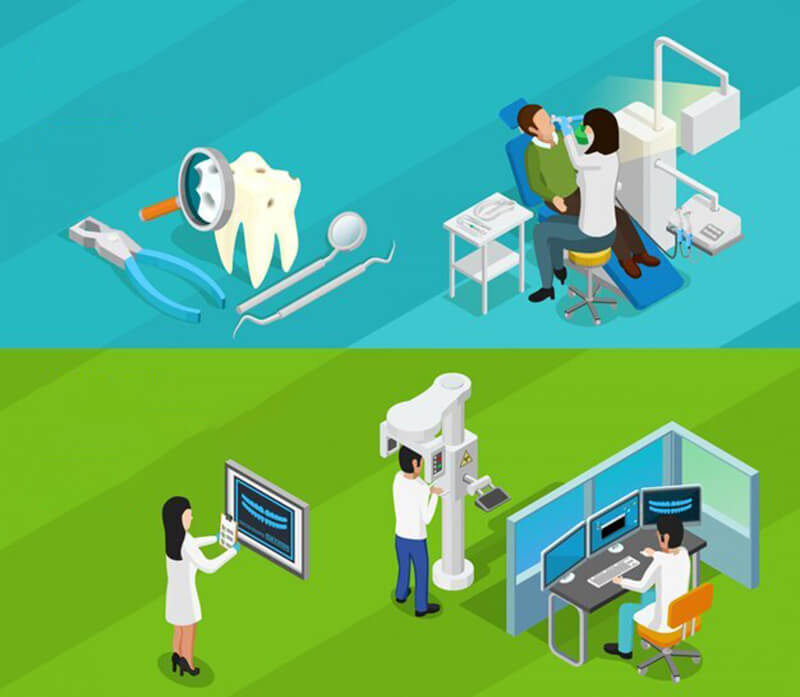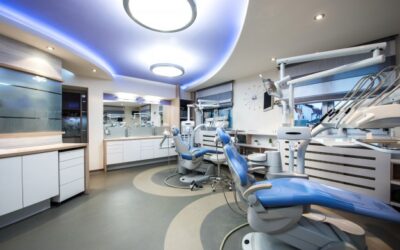Dentistry, as a field, has witnessed a remarkable evolution over the years. In the ever-evolving world of dentistry, new technologies and techniques have emerged. It has transformed the landscape of oral healthcare and paved the way for contemporary clinical dentistry .Contemporary Dentistry combines traditional clinical practices with cutting edge advancement. It has enhanced patient care and outcome.
Digital Dentistry: A Technological Leap
What is Digital Dentistry?
Digital Dentistry is a modern approach that utilizes the power of technology ,employing computer based tools and softwares. It aids in improving accuracy ,efficiency and patient satisfaction. It has emerged as a transformative force in the field of oral healthcare.Digital dentistry is shaping the future of dental care.

Main Advantages of Digital Dentistry
- Enhanced Precision Digital tools enable precise measurements, leading to accurate treatment planning and execution.
- Time Efficient It streamlines the treatment process by reducing the number of visits required.
- Improved patient experience Digital tools reduce patient discomfort and anxiety, leading to more positive dental experience
Modern Dentistry: Embracing Technological Innovations
It refers to the utilization of state of the art technologies and techniques to deliver advanced dental care. It encompasses a wide range of digital tools and equipment, revolutionizing various aspects of dentistry like:
Technology in Diagnosis and Treatment Planning
● Intraoral cameras: Visualizing the Unseen
Intraoral cameras have become an indispensable tool in modern dentistry, offering a closer view of the oral cavity. These small, handheld devices capture high-resolution images and videos. It provides a detailed view for accurate assignment and encourages a collaborative approach to dental care.
Advantages of intraoral cameras:
- Enhanced Patient Communication
- Accurate Diagnosis and Treatment Planning
- Improved Case Documentation
- Increased Patient Engagement and Education
- Enhanced Treatment Monitoring
- Strengthened Trust and Patient Satisfaction
● CBCT: Cone Beam Computed Tomography
Cone beam computed tomography (CBCT) has emerged as a revolutionary imaging technology in the field of dentistry. This advanced imaging technique provides detailed 3D images of the maxillofacial region, offering invaluable information for diagnosis, treatment planning, and improved patient care.
How is CBCT transforming the dentist approach towards various dental procedures?
- Improved Implant Planning and Placement
CBCT imaging has revolutionized the field of dental implantology. By providing a three-dimensional view of the patient’s jawbone, CBCT scans enable dentists to accurately assess bone volume, density, and quality for implant placement. This information aids in the selection of appropriate implant sizes and locations, ensuring optimal implant success rates and reduced complication during implant surgery.
- Enhanced Endodontic Treatment
CBCT imaging plays a crucial role in endodontic procedures, particularly in cases with complex root canal anatomy or persistent infections. It allows dentists to visualize intricate root canal systems, identify extra canals, and assess the extent of apical pathology. It also aid in the evaluation of post-treatment healing and can assist in determining the need for additional interventions.
- Orthodontic Evaluation and Treatment
CBCT imaging provides orthodontists with a comprehensive evaluation of the dentofacial complex, allowing for more accurate diagnosis and treatment planning. It helps in assessing tooth eruption patterns, skeletal relationships, and identifying potential airway obstructions. CBCT scans enable orthodontists to make informed decisions regarding treatment
- Minimally Invasive Dentistry
CBCT imaging promotes the concept of minimally invasive dentistry by enabling precise treatment interventions. With detailed anatomical information, dentists can plan and execute procedures with greater accuracy, reducing the need for exploratory surgeries or multiple interventions.
● 3D Digital Smile Designing: Personalized Aesthetics and Functionality
A groundbreaking technique that enables art and science to craft personalized smiles for patients. It involves capturing accurate 3D images of patient’s teeth and facial structure. Which are used to design and stimulate the desired smile transformation.
It has various advantages:
- It allows patients to preview their future smile,
- Foster better communication
- Ensure that both the dentist and the patient share a common vision.
Artificial Intelligence (AI) : Revolutionizing Dentistry
The rapid advancement of Artificial Intelligence (AI) technology has had a profound impact on various industries, and dentistry is no exception. AI has opened up new avenues for dentists, orthodontists, and oral health professionals.
AI is being utilized in dentistry in many exciting ways and is giving potential benefits to both dental professionals and patients like:
- Intelligent Diagnosis and Treatment Planning:
With this technology, dentists can make more informed decisions, leading to improved treatment planning and better patient outcomes. By analyzing dental images, like X-rays and scans, AI algorithms can identify and classify various oral conditions, including tooth decay, gum diseases.
DentalDost has a new age solution for screening and managing patients with Smart AI Check up Kiosk and DentalDost App, providing instant screening reports , with just three photos.
DentalDost Screening is:
- Both reliable and accurate
- Super fast
- User friendly
- Oral health tracker
- Provide cloud-based data storage
- Virtual Dental Assistants
Streamline administrative tasks, freeing up valuable time for dental professionals.
- Predictive Analytics for Oral Health
AI algorithms can leverage patient data, such as medical history, lifestyle habits, and genetic information. It provides predictive analytics for oral health. By identifying risk factors and patterns, dentists can proactively intervene and prevent potential dental problems.
- Enhanced Patient Communication and Education
AI-powered chatbots and virtual assistants can improve patient communication and education.
- Data Security and Privacy
Data security and privacy are of the utmost significance in the AI-driven dentistry world, as they are with any technology.
Technology in Treatment
● CAD/CAM Technology: Computer-aided design and manufacturing
It enables the creation of custom made dental restoration , such as crown and veneers, in a shorter time frame and with high precision.
It involves 4 steps:
- DATA ACQUISITION: Data acquisition refers to the digitization and processing of the patient’s clinical data, either with the use of an intraoral camera or by scanning plaster molds or dental imprints.
- CAD: Computer Assisted Design allows for the formation of a virtual model from the data collected in the previous step. This data is graphically represented prior to the creation of the prosthesis, with post-processing of the information collected from the ocular impression.
- CAM: Computer-assisted manufacture (CAM) enables the creation of a material object, which is a physical version of the virtual model generated via CAD. In this situation, specialized software creates the machining pathways, allowing the tool locations to be set and regulated during the manufacturing process.
- CNC:A numerically controlled machine is referred to by the abbreviation CNC. In practice, the material item is produced by the tool.
Through this process dentist gain several advantages:
- See the prosthesis before it is made, thanks to a preview of the artifact
- Refine its structure and tweak every detail
- Make prostheses with a large structure or very thin ones, as required
- Achieve a finished product of extreme precision
● Robotics in Dentistry
From surgical procedures to complex restorative treatments, robotic dentistry offers precise and efficient solutions. AI algorithms guide robotic arms, improving accuracy and reducing human error. This integration of AI and robotics paves the way for:
- Minimally invasive procedures,
- Shorter recovery times,
- More predictable outcomes.
Advantage of Digital Dentistry for the Dentist
- Simplify the detection of patients’ dental arch
- Reduce visit and labor times
- Eliminate the cost of material
- Avoid the burden of sent the impression to Dental Laboratory
- Eliminate the risk of manual errors
Advantage of Digital Dentistry for the Patient
- Improved overall experience and comfort during sessions.
- Reduced treatment time
- Enhanced treatment satisfaction
Limitation of Digital Dentistry
- Maintenance and upgradation of tools for optimal performance
- High initial investment
Clinical Dentistry : The Foundation of Dental Care
What is Clinical Dentistry?
Clinical dentistry represents the traditional practice of dental care. It employs manual tools and techniques for oral health management. Dentist in this realm rely on their extensive training skills, and expertise to diagnose and treat various oral diseases. In clinical settings they primarily utilize hand instruments, dental drills, physical impressions and X-rays to address various dental concerns of the patient .
This form of dentistry has a long-standing history and has served as the backbone of dental practice for many years.

Advantages of Clinical Dentistry
- Hands on approach Direct patient interaction.
It fosters a personal connection and enables dentists to provide a high level of care. - Proven Technique To effectively address oral health issues.
Over time, clinical dentistry has built up an extensive collection of tried-and-true treatments. - Familiar Workflow Predictable and reliable system
Dentists and dental workers are well-versed in traditional clinical processes, guaranteeing a predictable and trustworthy system.
Limitation of Clinical Dentistry
- Limited precision Manual techniques may have limitations in terms of precision, leading to potential error in treatment planning and execution.
- Patient Discomfort Some dental procedures may cause discomfort or anxiety in patients particularly those with dental phobia.
Clinical Contemporary Dentistry: Bridging Tradition with Technology
What is Clinical Contemporary Dentistry?
Clinical contemporary dentistry represents a combination of traditional clinical practices with modern advancement. It acknowledges the importance of manual techniques while incorporating digital tools and technology to enhance diagnosis , treatment planning and execution.
Advantages of Clinical Contemporary Dentistry
- Comprehensive Treatment planning Integration of both methods allow dentists to create a comprehensive treatment plan, considering the patient’s unique needs, Utilizing advanced digital tools for accurate diagnostics and stimulation
- Improved patient experience Patients can actively participate in their treatment decisions. It leads to higher satisfaction rates and improved treatment outcomes
- Time and cost efficiency Digital dentistry can streamline workflow. This reduces the time and resources required for certain procedures.
The Bottom Line
The field of dentistry has experienced a significant transition from traditional clinical dentistry to digital dentistry. While clinical dentistry remains the foundation of dental care, digital dentistry also offers numerous advantages and with integration of AI-powered systems and robotics it gives unprecedented accuracy, efficiency, and personalized care. Hence, the future of dentistry lies in a harmonious union of clinical expertise and digital technology. By embracing the advantage of both and harnessing the power of AI, the future of dentistry looks brighter than ever. It will improve oral healthcare outcomes and enhance patient experiences.
Highlights:
- Clinical dentistry relies on the skills and experience of dentists
- Digital Dentistry harnesses the power of technology to improve accuracy, efficiency and patient experience
- Integration of both the approaches can lead to the best possible outcomes
- Dentists can combine their clinical expertise with advantages offered by digital tools and techniques
- AI in dentistry shows immense promise.
- Dental practitioners must keep up with technological developments, receive the necessary training, and effectively use these tools
- The future of dentistry lies in the continued advancement and synergistic integration of clinical and digital approaches





its very nice
Very articulately written this blog by Dr Shruti Dani. The blog is quite in details and covers major aspects of recent advancements in the science of Dentistry. Frankly speaking these details I was unaware too. Kudos the her for her first blog and the details she tried to narrate in the blog.
Outstanding I must say !!
Keep writing and help society by educating Dental hygiene .
Best wishes